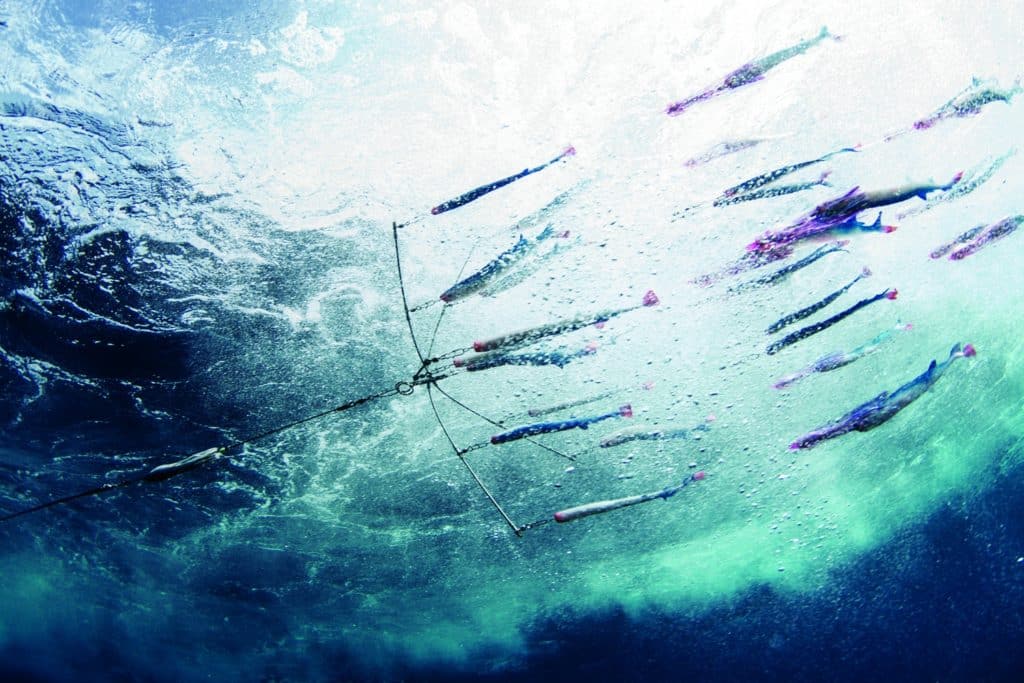
Baja striped marlin are caught mostly by sight-casting live bait to feeding or sunning fish. At least that was the case until 2005, when Miami Capt. Ray Rosher won the Rolex/IGFA Offshore Championship in Cabo San Lucas by trolling dead baits and dredges. The following year, Rosher and his wife, Charmain, joined by Tom Schramm and Scott Segal, again showed the all-star fleet just how productive dredges are with a tournament-record 24 marlin released for another win.
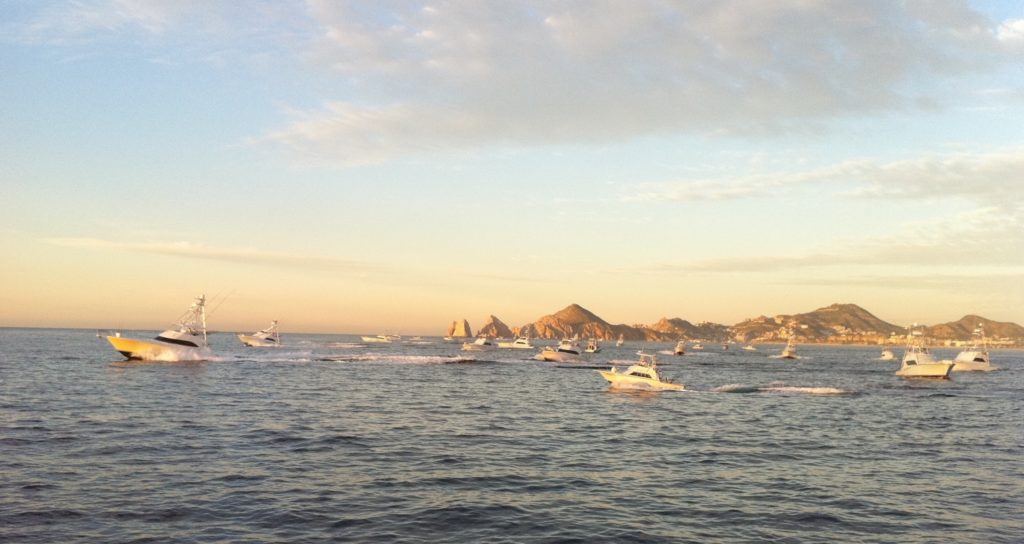
“Going into a tournament like that, with 60 or 70 teams, you feel like you need some kind of edge,” Rosher says. “I didn’t know what to expect, so I brought everything but the kitchen sink, from Mylar-strip dredges to kite stuff.” With sub-60 percent hookup averages on lures, and realizing kites wouldn’t be effective with the forecast calling for light winds, and a tournament maximum of 15 live baits, they settled on trolling fresh mackerel and ballyhoo plus a pair of Mylar-strip dredges to attract fish.
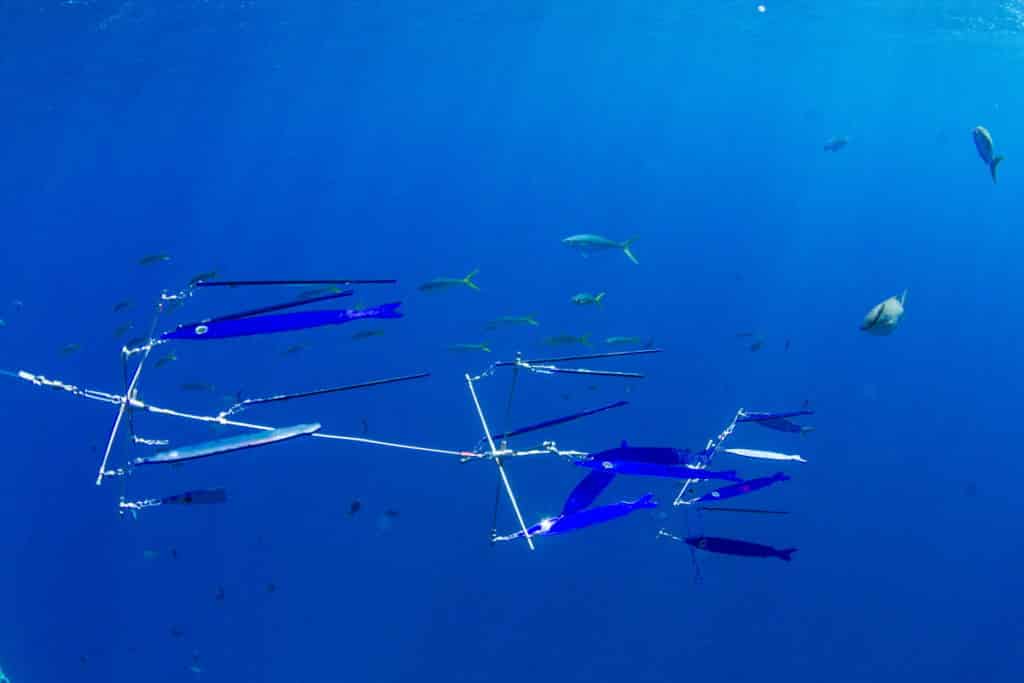
Stay Versatile with Trolling Strategies
We felt we were pretty good off the bow,” says San Diego Capt. Peter Groesbeck — West Coast boats install livewells on the bow to aid sight-casting — “but we looked at Rosher’s two wins and said, ‘How can we improve what we’re doing off the back of the boat?” That same year (2006) Groesbeck teamed with fellow West Coast captains Steve Lassley and Andy Horner, and Hawaii captains Randy Parker and O.B. Morton aboard Bad Company to win the largest tournament jackpot anywhere to date — $3.9 million at Bisbee’s Black and Blue Marlin Tournament — by slow-trolling live skipjacks, without dredges. But since then, Groesbeck, Lassley and many top West Coast tournament fishermen incorporate trolling dredges and teasers into their tactics.
“There are times dredge and teaser combinations outfish everything. Other times the fish won’t eat anything but live bait,” Groesbeck says. “You’ve got to be versatile. The more tools you have, the more you can adapt, then the more productive you’re going to be.” The bottom line, he says, is more fish raised to the boat with teasers and dredges.
I asked eight tournament-proven captains to share their thoughts on attracting more fish into the spread using teasers and dredges.
Teaser and Dredge Basics
Capt. Barry Kohlus first adapted striped bass and bluefish dredge techniques from Montauk to sailfish tournaments in Florida in 1985, where they became a mainstay of Treasure Coast sailfish trolling. Then Fort Pierce Capt. Glenn Cameron trolled dredges and teasers aboard Zeus and released a record 36 billfish to win the five-tournament 2011 Bahamas Billfish Championship, and that same year, Double Dog landed the new Bahamas record 1,119-pound blue marlin, also while pulling dredges and teasers. They became essential Bahamas marlin equipment.
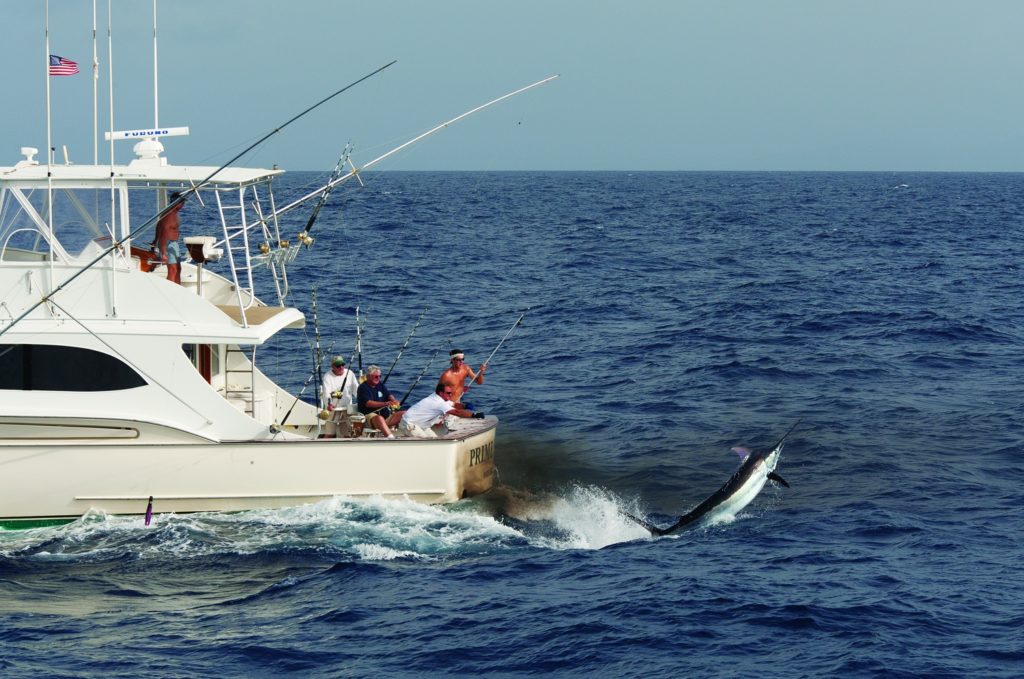
“We went from drag-and-snag lures to finesse fishing. We were seeing more fish and getting our hookup percentages in the 90s,” Capt. Cameron says.
“Fishing off the riggers, whether pulling lures or bait, we’re maybe 50 or 60 percent. You get one bite, the fish strips drag, and it’s gone. You never see the fish,” says Capt. Jamie Ralph who fishes billfish tournaments throughout Florida and the Bahamas (oldno7fishing.com). On the other hand, he says: “You see the fish come in on the teaser all lit up. It’s a lot more fun, and we’ll catch seven or eight out of 10 by pitching baits.”
Most often Ralph deploys one artificial dredge, usually with 12 Fire Tailz, and one natural dredge with as many as 16 wedged and deboned mullet — on single-tier 24-inch-diameter dredges trolled around 80 feet astern. Ralph runs one six-squid-chain teaser, typically ending with an Ilanders Express over a hookless tuna belly strip, about 160 feet back, and he pulls a hookless Leopard or Teaser lure from Primo at the same spot on the other side. To troll faster than 7 to 9 knots, Ralph foregoes the natural dredge.
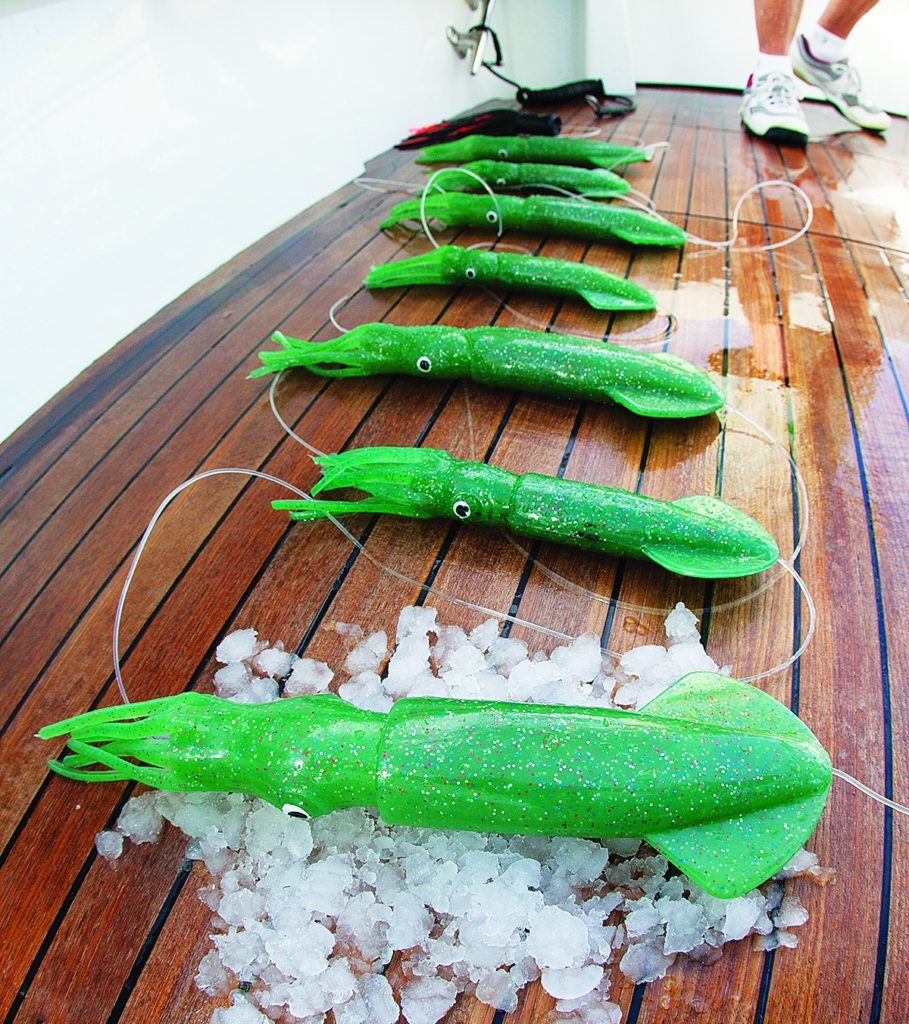
Ralph’s crew pitches hooked baits sized for fish that come into that presentation — generally select ballyhoo on 50-class reels and mackerel on 80s — plus he runs two outrigger baits and a smoking lure long down the center. “The goal is to tease a fish right to the transom. The rigger baits are there for a fish that won’t come in. I don’t want them way back in no-man’s land, but I don’t want anything to sidetrack fish on the teasers. Sometimes I also swim a ballyhoo on a flat line just a few feet behind and inside whichever dredge is natural, usually with a smaller offering if we’re in a tournament where we’re after whites and sails,” he says.
Bait-and-Switch Teaser Tactics
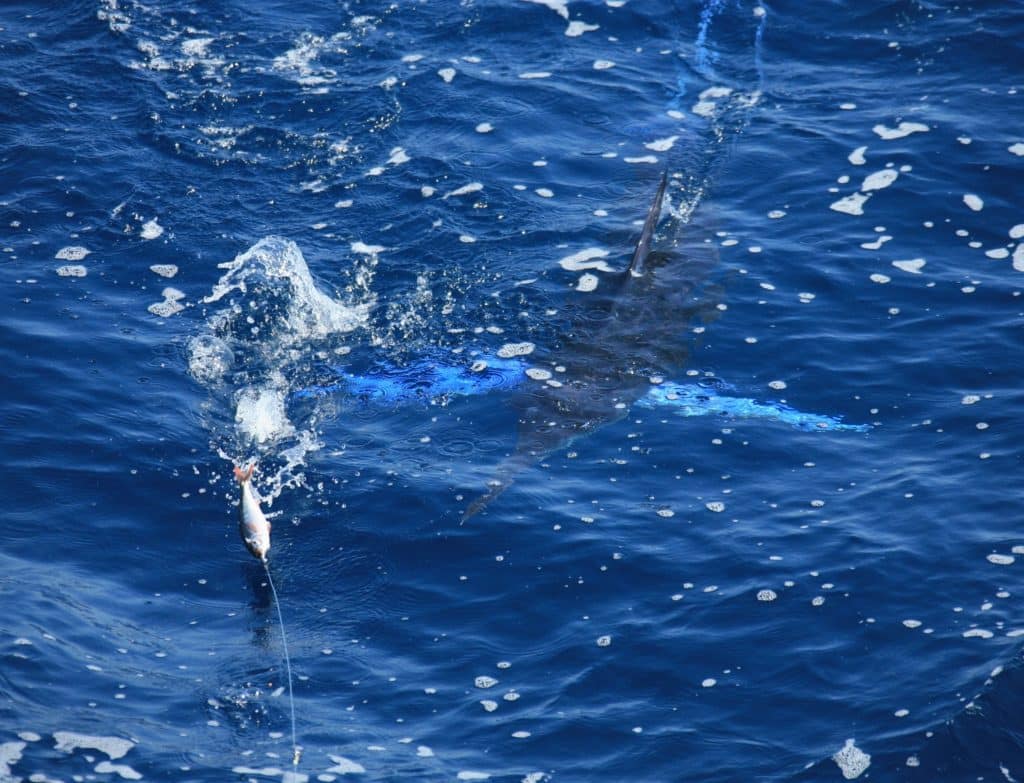
When a fish comes up, I turn toward it just enough to minimize [prop] wash and open a clear lane right to the boat. That also slows down the teaser, so it lays in the water a little longer,” Jamie Ralph says. “One guy sends a bait out right away, and another starts clearing the dredge on that side — not all the way in, but shortened up. I’m pulling in the teaser slow enough to engage the fish, but fast enough that the fish can’t engage me,” he says, which varies from gently coaxing to hurried. “If the fish isn’t keeping up with your retrieve, it hasn’t been teased enough yet. Keep the teaser just out of its reach. You want that fish so mad and hungry that when it finally sees that pitch bait, it wants to take a good bite out of it.” Ralph simultaneously adjusts his course so the angler’s pitch bait is directly in front of the fish.
For the angler’s part, Ralph says, “Use the length of the rod to move the bait enough to get the fish’s attention.” He says blue marlin seem to bite best when the bait is moving toward the boat, while sailfish seem to prefer the bait to be falling away from the boat. Once the fish has the bait, he says, “Keep the reel in free-spool until [waiting] feels uncomfortable. When you think it is time [to engage the drag], be calm and wait a little longer. When you’re coming up on the drag, come up a little slower than your adrenaline is telling you to.”
Dredge Setups for Inboards

Teasers in Conventional Trolling Spreads
Teasers and dredges also work well without the choreography of pure bait-and-switch fishing. “When white marlin come on the teasers, we feed them a flat line,” says Oregon Inlet Capt. Arch Bracher. If a small naked ballyhoo won’t entice a blue marlin, Bracher’s crew pitches a larger ’hoo rigged with a small Mold Craft Hooker. “That Softhead is easier for the fish to get its eyes on, and I like bright colors that the angler can see,” Bracher says. “If a blue marlin over 200 comes on the teaser, whoever is on the flat line pulls it away, and someone else gets a pitch bait out,” he says — usually horse ballyhoo also rigged with a Hooker in front, or a mackerel.
Bracher trolls two-tier dredges 50 feet behind his single-diesel boat, although twin inboards often require dredges farther astern to find clear water. Twenty-five baits on each are mostly mullet, with a few ballyhoo mixed in, with Ilanders adding color to half his dredge baits. He tows squid chains, with an Ilander and hookless ballyhoo trailer, on both port and starboard. “The lead squid is over the dredge,” he says. “Flat lines are 6 or 8 feet behind the Ilander on that squid chain.”
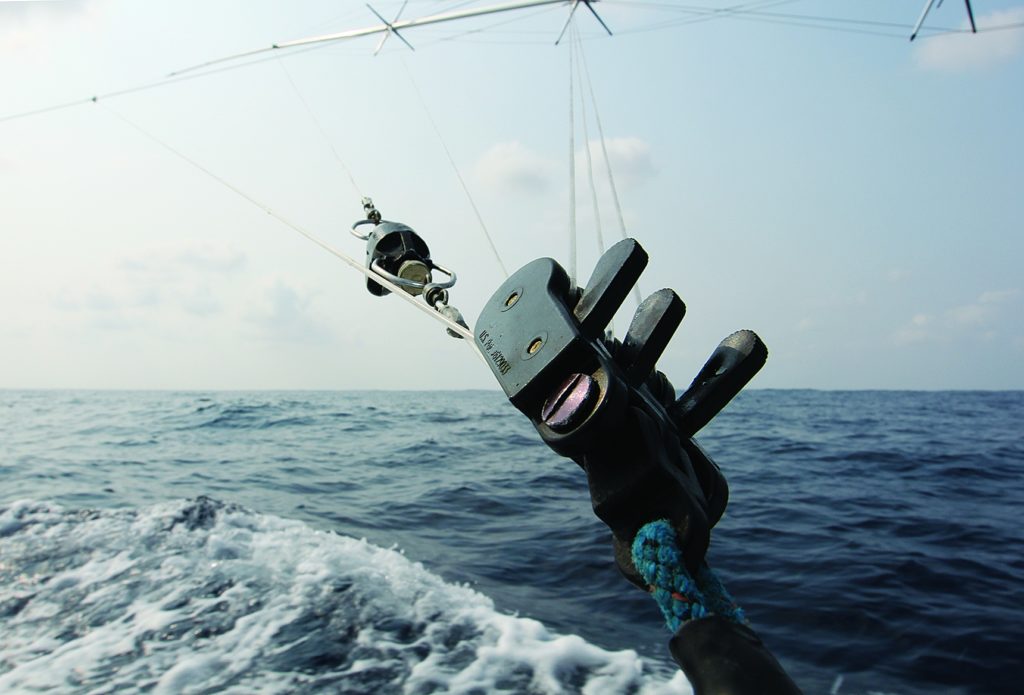
Bracher fishes a short center line on 80-class tackle from the bridge, which is rigged with a large armed ballyhoo behind an Ilander and trolled about double the distance of the flat lines. “A blue marlin will find that, or if a white gets after it, I’ll [tease] it in and present a flat line or a pitch bait,” he says.
Two outrigger lines at triple the distance of the flat lines, and a center rigger line even farther back, troll naked ballyhoo. “If there are a lot of blue marlin around, we might put a larger bait in the left rigger and substitute the squid chain on that side with something like a [Black Bart] Puerto Rican Prowler or Braziliano,” Bracher says.
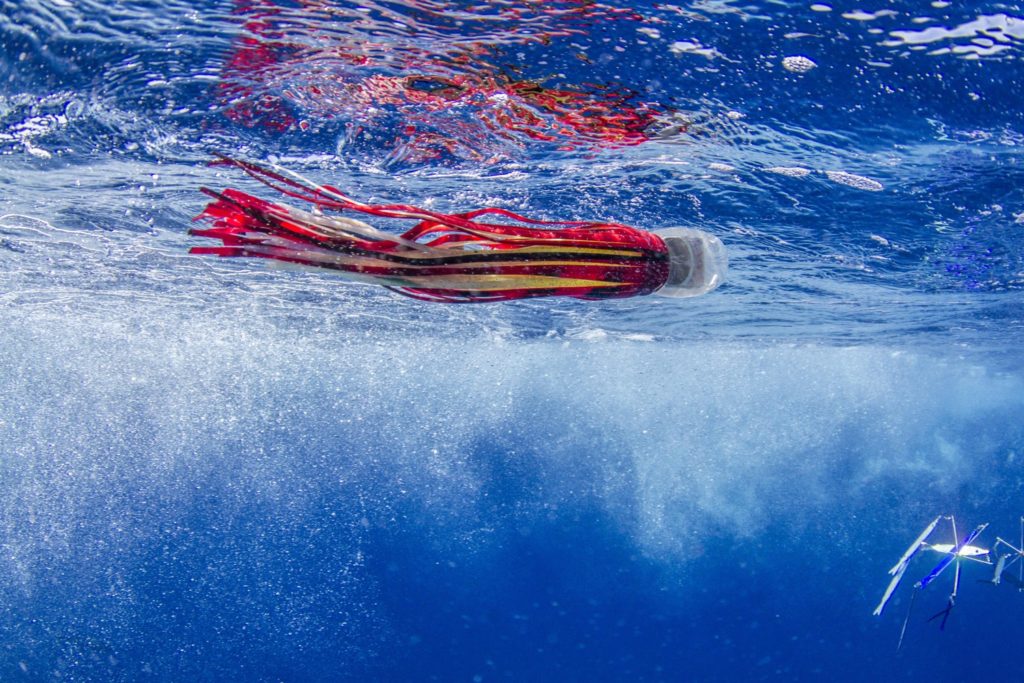
Hooking Fish with Trolled Baits
“You have to [see and] beat that fish to the pole. If it pops the pin before you get to the rod, your percentages drop.” Bracher says. “The key to hooking a billfish on a rod and reel is that it doesn’t feel you. That’s a lot easier with the fish attacking while swimming toward you. It’s not like fishing a fly, where you’re trying to get that fish to turn and bite when it’s swimming away from the boat.” Like Ralph, Bracher turns the boat a bit toward the bite to clear the wake. “Get the dredge in on whichever side the fish is on, so you’re not baiting the fish right over the dredge, but leave the other side alone. You have a fish, so you know you’re in the right spot. Take advantage of that as long as you can.”
West Coast Variation on Teasers and Dredges
Off California and Mexico, Groesbeck trolls a pair of two-tier dredges — rigged with squid when striped marlin are in deep water or mullet when they’re feeding close to shore — plus a pair of squid chains tipped with hookless ballyhoo on an Ilander or Chugger. While searching for fish, Capt. Pete Groesbeck trolls a full spread of ballyhoo at around 6.5 knots — two on flat lines behind and inboard of his dredges but ahead of his squid chains, plus two long rigger baits and a center-rigger, longer still. “When fish show up on the chains and dredges, you really don’t need the long baits,” he says, “but sometimes they’ll eat only off the riggers.” In full search mode, he forgoes dredges and pulls lures at 9 knots.

Groesbeck’s crew also pitch-rigged ballyhoo or live greenback mackerel or bigeye scad to fish in the trolled spread. “With striped marlin, we’ll raise one, but there still might be four or five fish that you don’t see,” Groesbeck says. “We’ll pull the chain in and slide a ballyhoo or a live bait back. When we hook up, we might slide another live bait out,” he says — essentially “prospecting” off the dredges. “Sometimes I go in a circle and free-spool the dredge, and I’ll bring a whole school up.” While fighting fish off the stern, other anglers are scanning from the bow, where another live-bait well keeps bait at the ready.
Pulling Dredges and Teasers from Outboard Boats
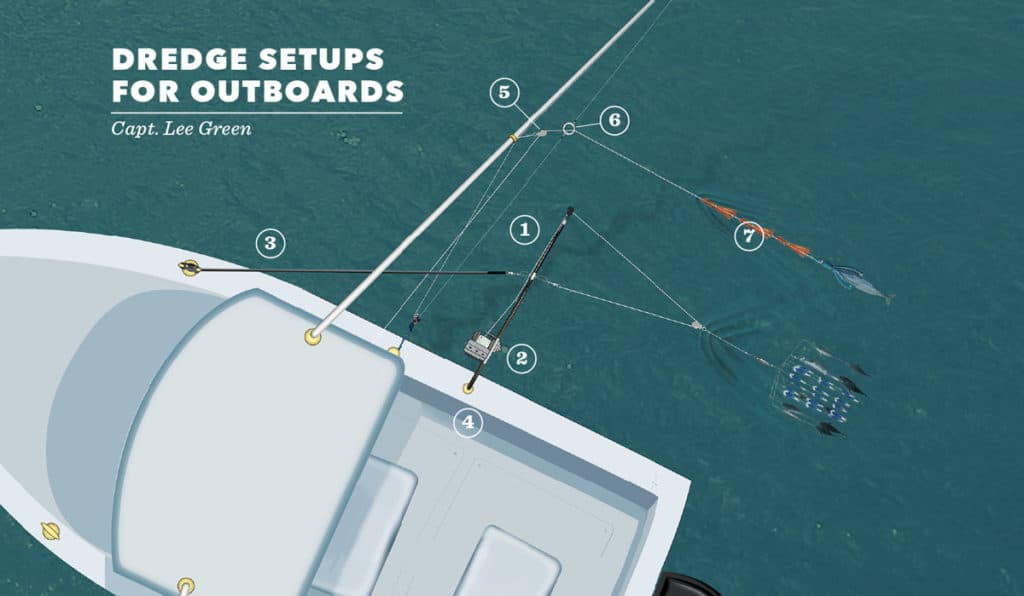

Capt. Barry Brightenburg often fishes with Groesbeck aboard the 66-foot Viking Controlled Chaos, but he developed different teaser methods for outboard-powered boats off San Diego. “We could beat the big boats when the fish are up on top feeding, but otherwise, the big boats dominated lure fishing,” he says. Brightenburg compensated for a center console’s smaller footprint and diminutive spread by adding bowling-pin-type teasers towed from stern cleats. “That adds a second-tier predator — something that looks like a bonito or small tuna in our spread. It added noticeably to the fish we raised.”
To overcome the difficulties of towing teasers from stern cleats, Brightenburg has since switched to putting squid chains on the same line as his marlin lures, which he trolls from his outriggers, plus a pair of flat lines with rigged ballyhoo. “I’m trying to get as many baits as I can behind the boat to activate the fish. I like them lit up, wanting to be part of the party, not just ghosting in and looking.”
While those outrigger-trolled squid-chain lures typically have hooks, more often than not Brightenburg’s crew switches marlin onto pitched live bait or ballyhoo, which gains a much better hookup ratio than lures. In good weather, he pulls that spread at 6 to 7 knots, or as fast as 8½ knots with just four squid chains with lures. “That added the dimension we needed to raise fish [in the same numbers as] the rest of the fleet. With the speed of the center console, now we’re deadly.”

In Texas, Capt. Scott McCune’s 31 Bertram has been repowered with twin 350 Yamaha outboards on a transom bracket, which complicates dredge presentations. “There is no doubt that meat dredges with 30 mullet are better,” he says, “but holographic-strip dredges are successful, they don’t tangle, and the strips are easy to replace.” He tows small dredges from pancake-style teaser reels over his helm through pulleys on conventional double-spreader outriggers. That wide spread helps avoid outboard props, but for T-top outriggers he suggests pulling just one dredge, always positioned so a slight turn away from a weed line pushes the dredge away from propellers.
McCune often runs Big Kahuna, Dancing Dolphin or Black Bart Extreme Breakfast teasers right from his transom cleats. “When the bait won’t come off a weed line, all kinds of predators, not just billfish, see those plastic chicken dolphins feeding on something, and it gets them fired up,” he says. Fifteen feet of thin braided nylon line, which is easy to pull by hand, ends at a snap swivel where 6 feet of mono continues to the teaser. “That line stays half way up the motor cowlings. As soon as a person standing in the cockpit pulls on it, the teaser pops right to the surface, away from the propellers.”
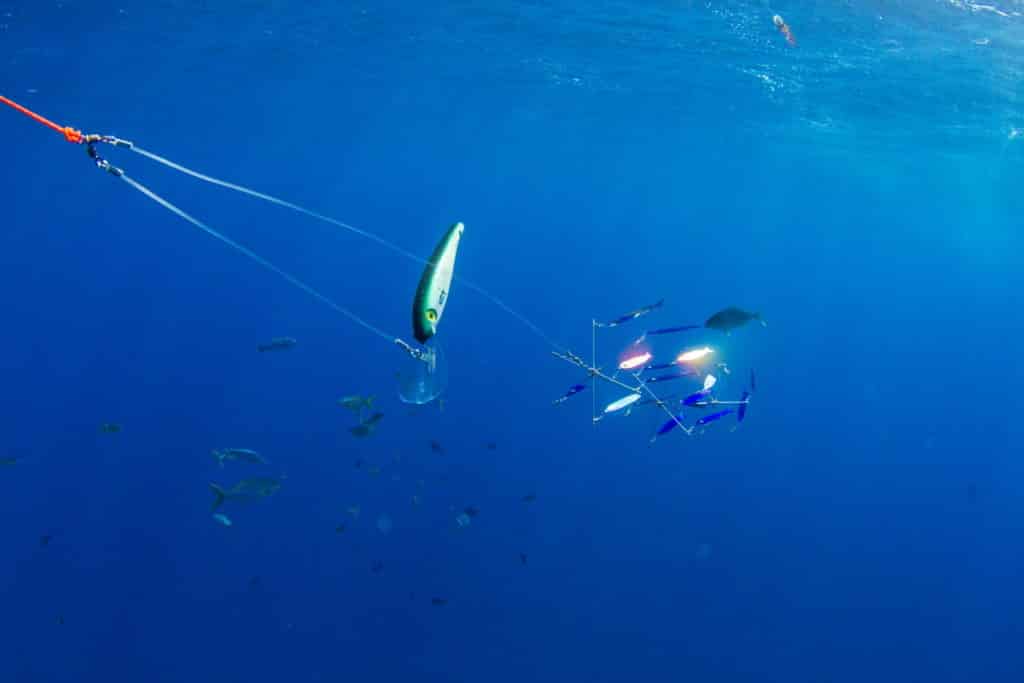
In Rosher’s Rolex/IGFA win, where the team fished from a different charter boat each day, he similarly pulled dredges from transom cleats with Mann’s Stretch 50s to hold them deep. “You’ll invariably find one that swims left and one that swims right,” he says, which pulls dredges away from the boat. Rosher runs 50 feet of ¼-inch nylon rope to 40 feet of 400-pound mono. From there, a three-way swivel leads down to the Stretch 50 on 2 feet of 400 mono, while another 4 feet of 400 mono leads back to the dredge — in this case, a Stripteasers 105-bait holographic strip dredge.

Teasers and Dredges — Billfish and Beyond
Dredges are also finding their way back to Montauk, and not just for billfish. “Tuna — bluefin, yellowfin and bigeye — might eat 15 feet behind the boat. A dredge 30 feet behind the boat is in the danger zone of getting tangled or eaten,” warns Capt. Bryce Poyer out of Shinnecock, New York. His compromise runs dredges no more than 20 feet astern with flat lines 10 feet farther aft.
Many local skippers add hook-rigged teasers into their 9- to 13-rod spread. “We get Squid Nation Flippy Floppys unrigged,” Poyer says. “Rig three or four in a chain followed with an Ilander or Junior with a [hook-rigged] ballyhoo. Run that off the short rigger right where a squid chain teaser would be.” Poyer also places diving plugs on flat lines behind and below dredges. “That looks like a straggler coming off the bait school.”

Fender teasers or bowling pins tow well from transom cleats, rigged with 15 feet of 5/16 rope, a heavy swivel and 12 feet of 600-pound mono. “You’re imitating a predator — a 10-pound whatever in your spread,” Capt. Bryce Power says. Similarly, he runs an aggressive lure, like a Mold Craft Super Chugger, behind a squid chain.
“Techniques that work in one place can be used successfully in a lot of places,” Rosher says. His Rolex/IGFA wins and the rapid spread of teaser and dredge combinations clearly show that.
“There are guys fishing Bisbee’s from the East Coast pulling a whole spread of bait. Others come from Hawaii pulling all lures,” Groesbeck says, and both have applications on the West Coast. “Dredges and teaser chains are just another tool we use to try not to be one-dimensional.”

Teaser Tips From Three Pros

CAPT. JAMIE RALPH — Dredges run off short, stiff rods with electric reels in the front corners of the cockpit, where 300-pound monofilament runs through a pulley on the outrigger, down to another pulley on the dredge, and then back to the outrigger in a V-pattern that offers 2-to-1 mechanical advantage but minimizes tangles. A third pulley rides loosely on the outside-most dredge line to haul it toward the cockpit when retrieved. His squid chain and teaser lure each run from electric reels mounted above his helm station.
CAPT. ARCH BRACHER — His dredge rig couldn’t be much simpler — a pair of long-poled Penn downriggers mounted in rod holders turned directly outboard, with a safety line running from downrigger tip to his outrigger base. Then 300-pound mono runs out to a pulley one-third of the arm length in from the tip, then aft to a pulley on the dredge, and then back up to the tip of the downrigger arm. “We replaced one of the aluminum poles with a stout fiberglass blank,” he says. “The give in the rod takes the strain of the dredge a little better than the aluminum.” A 6-pound lead shackles directly to each dredge, then 3 feet of mono shackles to the pulley on the downrigger line. Bracher runs squid chains, with an Ilander and hookless ballyhoo trailer, on both port and starboard from 300-pound mono on Penn 6/0 Senators mounted to the bridge rail. He pulls those teasers by hand. Dacron loops on the mono hang on teaser-reel handles when fully retrieved.
CAPT PETE GROESBECK — Off California and Mexico, Groesbeck uses a standard East Coast two-tier dredge, Lindgren Pitman reels on short rods, and a typical outrigger and dredge two-pulley setup. He also runs a pair of squid chains, tipped with hookless ballyhoo on an Ilander or Chugger, off bridge teaser reels aft and outboard of the dredges.
About the Author

LEARN MORE!
Find out How to Attract Big Fish to Your Boat* and discover How to Determine Optimal Trolling Speeds for Offshore Fishing.








